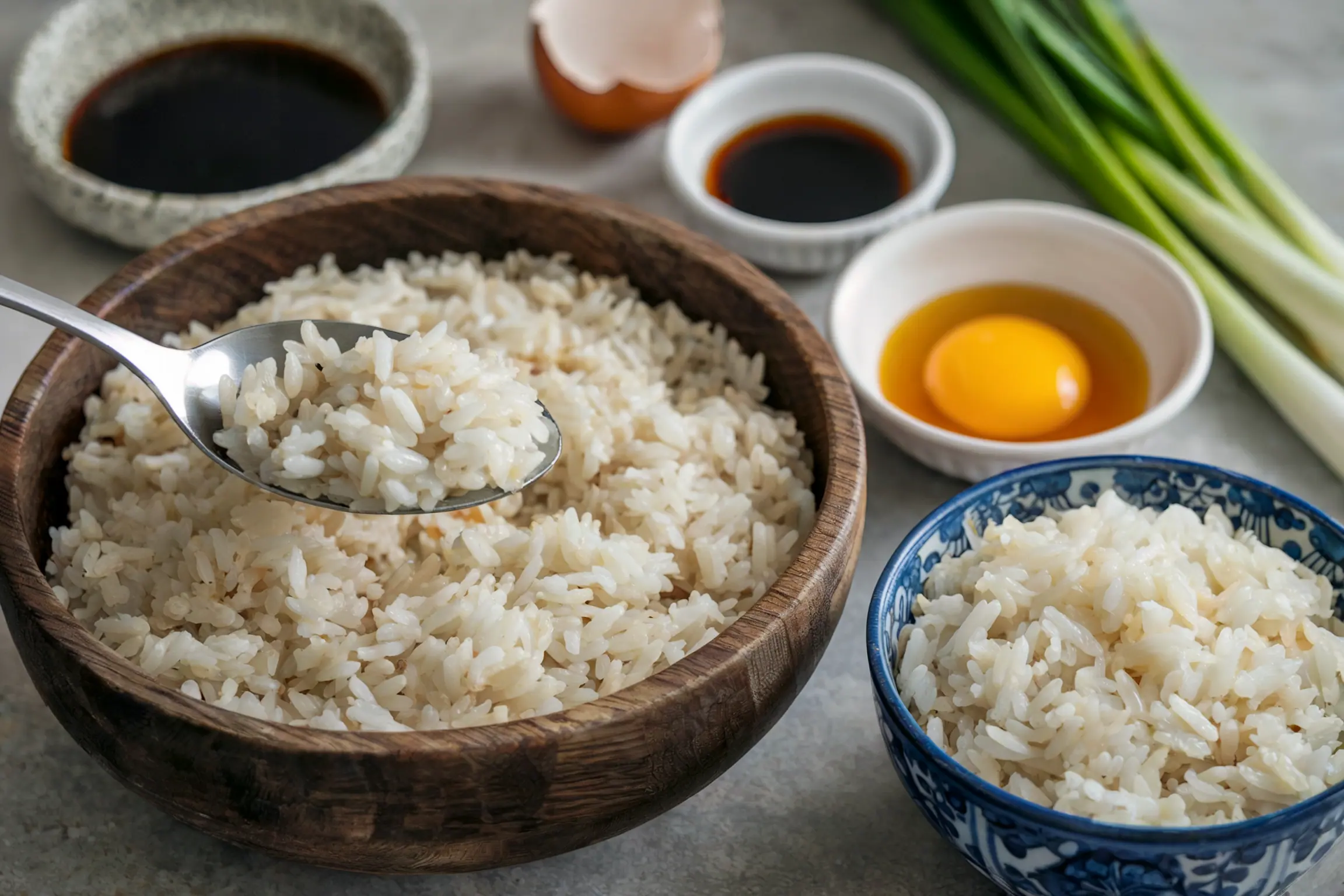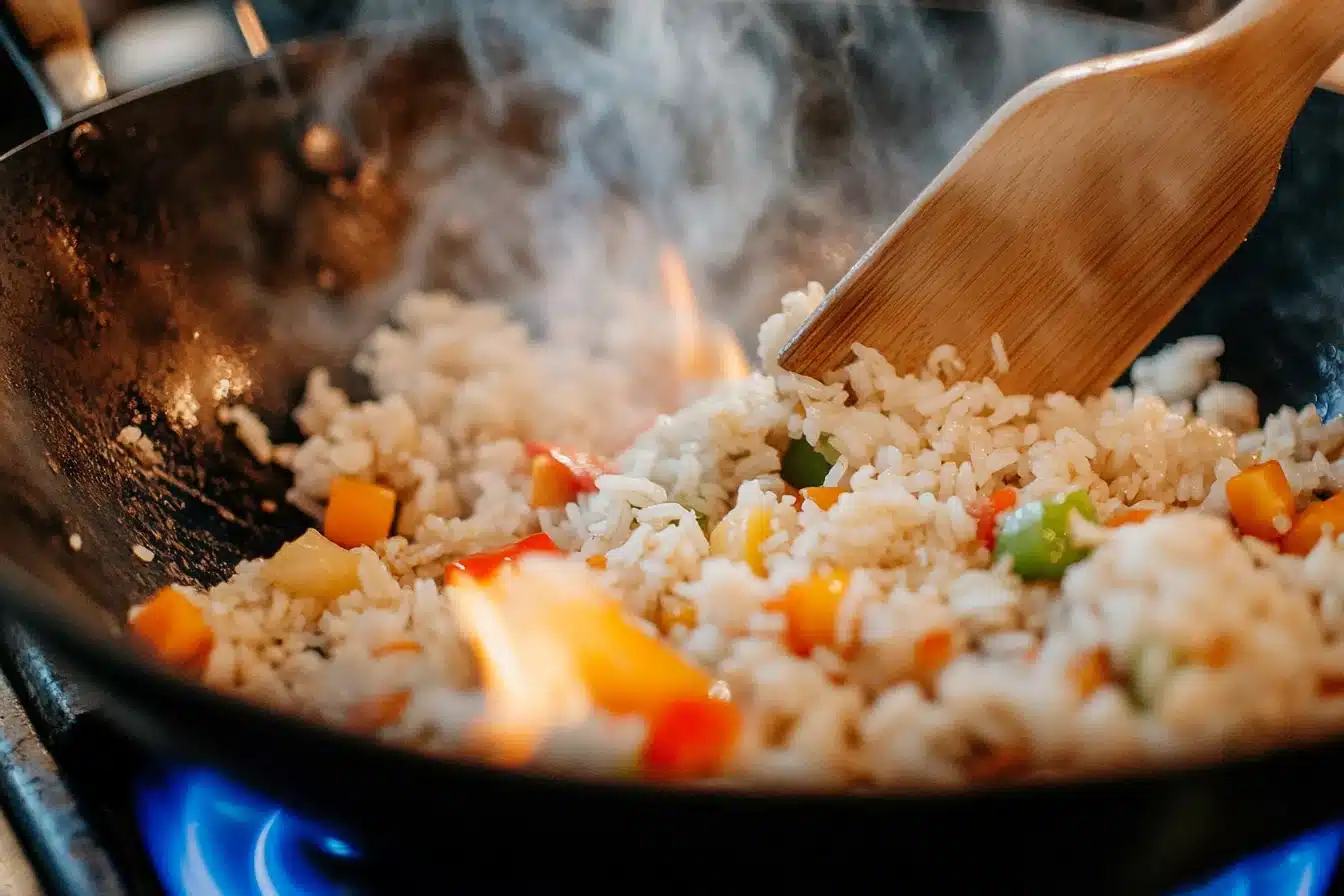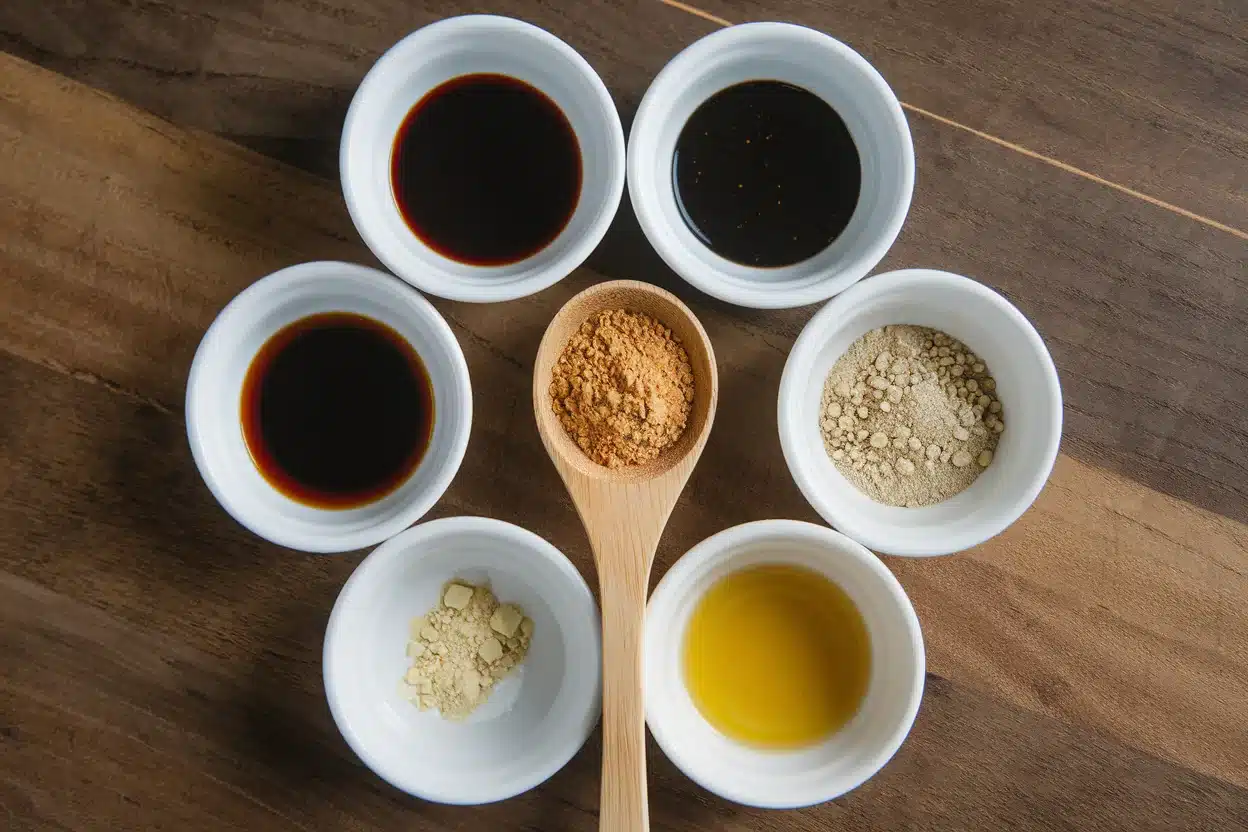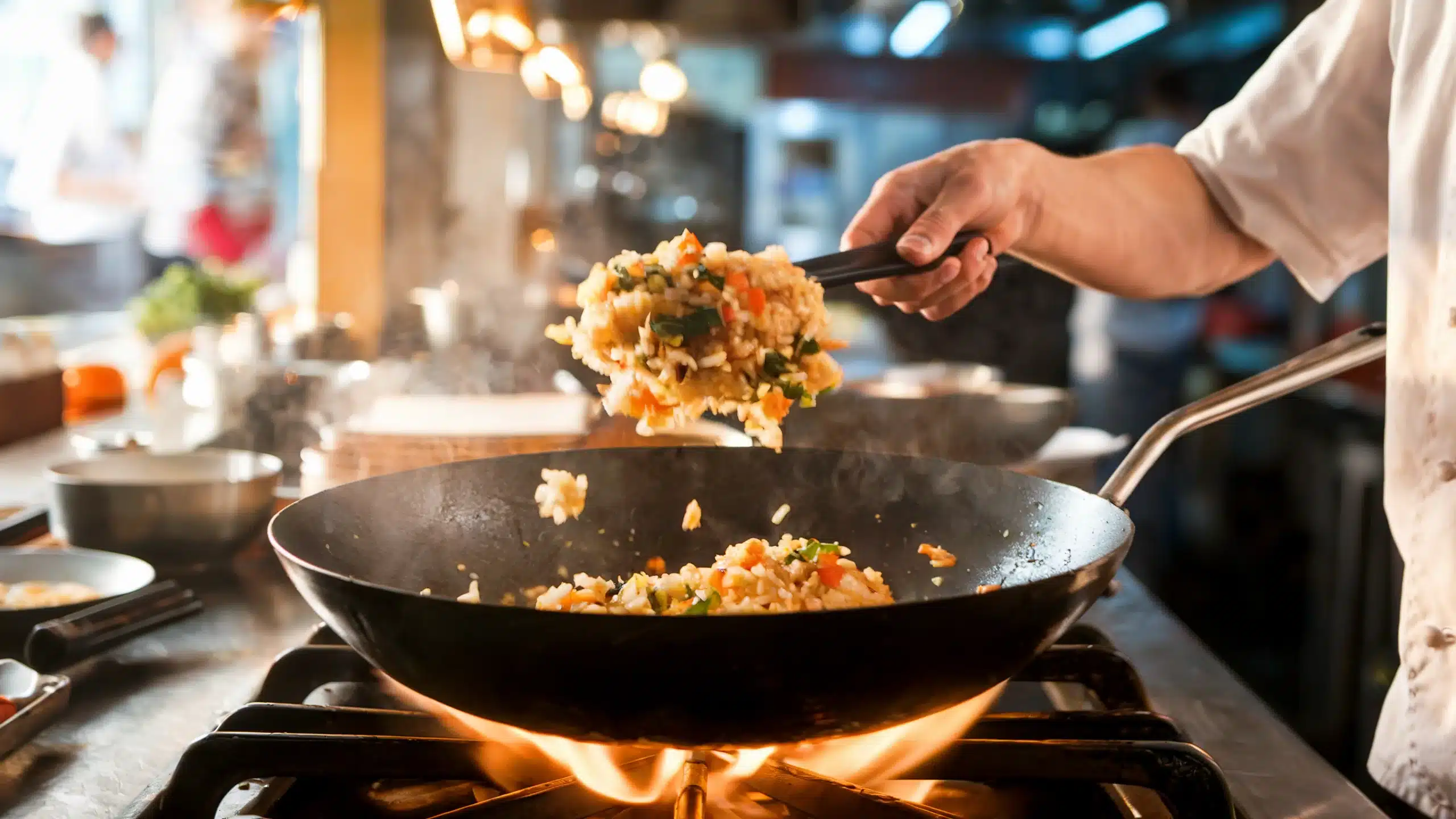What is the secret ingredient to restaurant fried rice? Many home cooks struggle to recreate that rich, smoky, and umami-packed flavor found in their favorite takeout. The truth is, there’s one key ingredient that makes all the difference—but it’s not just about what you add. The secret also lies in how you cook it.
We’ll uncover the secret ingredient that makes restaurant fried rice irresistible, along with the right techniques, seasonings, and common mistakes to avoid.
In This Article
Let’s dive in and unlock the secrets to perfecting restaurant-style fried rice at home!
The Popularity of Fried Rice and Why It Tastes Different in Restaurants
Fried rice isn’t just a side dish—it’s a global favorite. Found in Chinese, Thai, Japanese, and even American cuisines, this humble dish transforms simple ingredients into a flavorful masterpiece. But have you ever noticed that homemade fried rice never quite tastes like what you get at your favorite restaurant?
The Popularity of Fried Rice
Fried rice has been a staple in Asian cuisine for centuries, originating as a way to use up leftover rice. Over time, it evolved into a dish packed with rich flavors, umami seasonings, and aromatic ingredients. Today, you’ll find variations like:
- Chinese fried rice – often made with soy sauce, eggs, and vegetables.
- Thai fried rice – featuring fish sauce and fragrant jasmine rice.
- Japanese hibachi-style fried rice – cooked on a flat-top grill with butter and garlic.
Each style has its unique touch, but all share one thing in common: restaurant fried rice always tastes better.
Why Restaurant Fried Rice Tastes Different
If you’ve tried making fried rice at home only to end up with a soggy or bland dish, you’re not alone. The secret to restaurant-quality fried rice isn’t just about what goes into it—it’s about the technique. Here’s why restaurant versions always stand out:
- High Heat & Wok Cooking – Restaurants use extremely high heat and a seasoned wok, which adds a smoky, charred flavor known as wok hei. Most home stoves can’t reach the same intensity.
- Properly Cooked Rice – The best fried rice is made with day-old rice that’s dry and firm. Freshly cooked rice is too soft and clumpy.
- Secret Seasonings & Umami Boosters – Many restaurants use ingredients like oyster sauce, MSG, or fish sauce to amplify flavor.
- The Right Order of Cooking – Professional chefs know exactly when to add eggs, vegetables, and sauces to create the perfect balance.
The Secret Ingredient to Restaurant Fried Rice
Every great dish has a key ingredient that makes it stand out, and fried rice is no exception. So, what is the secret ingredient to restaurant fried rice? Many people assume it’s soy sauce, but while that plays a role, it’s not the real game-changer.
Understanding Umami: The Key to Authentic Flavor
If there’s one thing that makes restaurant fried rice taste richer, it’s umami. This deep, savory taste comes from ingredients high in glutamates, which enhance flavor without overpowering the dish. While soy sauce contributes to umami, restaurants often use MSG (monosodium glutamate) to elevate the taste further.
MSG has been a controversial ingredient, but it’s scientifically proven to be safe and widely used in Asian cooking. If you prefer natural alternatives, try mushroom powder, fish sauce, or a dash of oyster sauce—all excellent umami boosters.
The One Ingredient Most Home Cooks Miss
The real secret ingredient many restaurants use is chicken powder or bouillon seasoning. It’s a simple trick that packs in extra umami, giving fried rice that rich, savory depth. Many home cooks skip this step, relying only on soy sauce, which doesn’t provide the same intensity of flavor.
Here’s how to use it:
- Add ½ teaspoon of chicken powder per cup of rice.
- If vegetarian, substitute with mushroom seasoning or a small splash of liquid aminos.
- Combine it with a bit of white pepper and sesame oil for a balanced taste.
Other Essential Flavor Boosters
While MSG and chicken powder are game-changers, restaurants also rely on:
- Garlic oil – A drizzle adds a rich aroma.
- Butter – Used in hibachi-style fried rice for extra richness.
- Shaoxing wine – A touch of this Chinese cooking wine deepens the flavor.
Adding these elements together creates a bold, restaurant-quality taste—something that’s hard to achieve with soy sauce alone.
Choosing the Right Rice for the Best Fried Rice

Even with the perfect seasoning, fried rice falls flat if the rice itself isn’t right. The texture should be light, fluffy, and separate—not sticky or mushy.
Why Day-Old Rice is the Best
Freshly cooked rice holds too much moisture, making fried rice clump together. This is why restaurants always use day-old rice—it’s dried out enough to absorb flavors while staying firm.
If you don’t have leftover rice, you can:
- Spread fresh rice on a baking sheet and refrigerate it for a few hours.
- Use less water when cooking rice so it’s drier from the start.
- Choose the right rice variety for a better texture.
The Best Rice Varieties for Fried Rice
Not all rice works for fried rice. The best choices are:
- Jasmine rice – Used in Thai and Chinese restaurants for its fragrant aroma.
- Medium-grain rice – Offers a good balance between softness and separation.
- Long-grain rice – Less sticky, making it ideal for distinct grains.
Some chefs also swear by using a mix of white and brown rice for added texture and flavor.
For more details on preparing rice for high-heat cooking, check out Do You Cook the Rice Before Putting It on the Blackstone?.
How to Prepare Rice for Optimal Texture
Once you have the right rice, follow these steps for perfect fried rice:
- Cool it down – If using fresh rice, let it sit at room temperature before frying.
- Break it up – Use your hands to separate grains before adding to the pan.
- Use high heat – This prevents sogginess and helps achieve the signature wok hei flavor.
Speaking of high heat, Fried Rice on Blackstone dives deeper into the techniques used on flat-top griddles to get restaurant-style crispiness.
Restaurant Cooking Techniques That Make a Difference

Even with the perfect seasoning, restaurant fried rice stands out because of the way it’s cooked. The technique is just as important as the ingredients!
High Heat: Why a Wok Matters
One of the biggest differences between home-cooked and restaurant-style fried rice is wok hei—the smoky, slightly charred flavor you get from cooking at very high heat. Traditional restaurants use carbon steel woks heated to extreme temperatures, allowing rice to sear instantly.
Here’s why high heat is essential:
- It prevents the rice from getting soggy.
- It adds a subtle smoky depth.
- It quickly caramelizes the soy sauce, boosting umami.
If you don’t have a wok, a cast-iron skillet or a Blackstone griddle can also get the job done. Check out Fried Rice on Blackstone for more tips on achieving that signature restaurant texture.
The Role of Oil and Proper Stir-Frying
Another key to restaurant-style fried rice is the right oil. Many people use olive oil, but neutral oils like peanut, vegetable, or sesame oil work better since they have a higher smoke point.
To achieve perfect fried rice, follow this stir-fry technique:
- Heat your pan until it smokes—this prevents sticking.
- Add oil and aromatics first—onions, garlic, and ginger release their flavors best in hot oil.
- Push everything aside and crack an egg—this helps create those delicious egg ribbons.
- Toss the rice continuously—this keeps it from clumping and ensures even seasoning.
The Order of Ingredients: When to Add Each One
Timing is everything! Adding ingredients in the wrong order can ruin the texture. Here’s how restaurants do it:
- Oil and aromatics first – Garlic, ginger, and onions should sizzle before anything else.
- Eggs next – Lightly scramble them before mixing them into the rice.
- Rice goes in third – Day-old rice absorbs flavors best.
- Protein and vegetables last – This prevents overcooking.
- Sauces at the very end – Adding soy sauce too early makes rice mushy.
By following this process, you’ll get that authentic restaurant-style texture every time.
Secret Seasonings and Enhancers Used in Restaurants

If you’re still wondering, what is the secret ingredient to restaurant fried rice?—seasonings play a huge role. While we’ve discussed MSG and chicken powder, there are other key ingredients that make a big difference.
Soy Sauce vs. Oyster Sauce: Which One is Better?
Soy sauce is often the first thing people think of when making fried rice, but oyster sauce is just as important. Here’s how they compare:
- Soy Sauce – Adds a salty, umami depth. Use light soy sauce for color and dark soy sauce for a richer taste.
- Oyster Sauce – Thicker and slightly sweet, it gives fried rice a more complex flavor.
The best method? Use a combination of both for a perfectly balanced dish.
The Hidden Power of MSG and Alternatives
We mentioned MSG (monosodium glutamate) earlier, but some people prefer alternatives. Here are some great substitutes that still enhance umami:
- Mushroom powder – Made from dried shiitake mushrooms, this adds a natural, earthy umami.
- Fish sauce – A little goes a long way! It deepens the flavor without overpowering the dish.
- Chicken bouillon powder – Used in many restaurants for an extra savory kick.
Adding just ½ teaspoon of any of these per cup of rice can make a noticeable difference.
Aromatics: Garlic, Ginger, and Scallions
Restaurants never skip aromatics, as they provide layers of flavor. The key ingredients include:
- Garlic – Minced and sautéed in oil for a rich aroma.
- Ginger – Adds warmth and a slightly spicy depth.
- Scallions – Used both during cooking and as a garnish for freshness.
A pro tip? Infuse oil with garlic before cooking to give your fried rice a restaurant-style aroma!
For more delicious Asian-inspired recipes, check out Kimchi Chicken Fried Rice for a spicy twist.
Common Mistakes to Avoid When Making Fried Rice
Even with the right ingredients and seasonings, small mistakes can prevent you from achieving restaurant-quality fried rice. Avoiding these common pitfalls will help you master the dish at home.
Using Freshly Cooked Rice
One of the biggest mistakes home cooks make is using freshly cooked rice. Fresh rice is soft, moist, and sticky—completely opposite of the dry, firm grains needed for perfect fried rice.
To fix this:
- Always use day-old rice, stored in the fridge overnight.
- If you must use fresh rice, spread it out on a tray and refrigerate for at least an hour before frying.
- Cook rice with less water than usual to keep it drier from the start.
Overloading the Pan with Ingredients
Too many ingredients can lower the heat of the pan, making the rice steam instead of fry. This results in soggy, clumpy rice instead of light, fluffy grains.
To avoid this:
- Use a large wok or skillet to give the rice enough space.
- Cook in small batches to maintain high heat.
- Stir-fry quickly to keep ingredients crisp and flavorful.
Incorrect Oil Choice
Using the wrong oil can affect both the taste and texture of fried rice. Olive oil is not ideal since it has a low smoke point and a strong flavor that overpowers the dish.
Instead, use:
- Peanut oil – A neutral oil with a high smoke point.
- Vegetable or canola oil – Light and perfect for frying.
- Sesame oil – Adds flavor but should only be used at the end, not for frying.
Adding Sauce Too Early
Adding soy sauce or other seasonings too soon can make the rice mushy. It’s best to:
- Cook everything first, then add sauces at the very end.
- Drizzle sauces around the edge of the pan so they caramelize before mixing with the rice.
- Use a light hand—too much soy sauce makes fried rice wet and salty.
By avoiding these common mistakes, you’ll get fried rice that’s crispy, flavorful, and just like what you’d find in a restaurant!
Conclusion & Final Tips for Perfect Fried Rice
After exploring what is the secret ingredient to restaurant fried rice, we now know that it’s not just one thing—it’s a combination of the right seasoning, technique, and ingredients.
Summary of Key Takeaways
To make restaurant-quality fried rice at home, remember these essential tips:
✔️ Use day-old rice for the best texture.
✔️ Cook on high heat to achieve the smoky wok hei flavor.
✔️ Enhance umami with MSG, chicken powder, or mushroom seasoning.
✔️ Stir-fry in the right order—aromatics first, rice in the middle, and sauce last.
✔️ Avoid overcrowding the pan to keep everything crisp.
Experimenting with Your Own Secret Ingredient
Every chef has their own twist on fried rice. Once you’ve mastered the basics, try experimenting with:
- Different proteins – Shrimp, beef, or tofu.
- Extra umami boosters – Fish sauce, miso paste, or butter.
- Spicy variations – Add chili oil or sriracha.
Fried rice is a versatile dish, so don’t be afraid to get creative! With the right techniques and ingredients, you’ll be making better-than-takeout fried rice in no time.
For those looking to master the art of high-heat wok cooking, The Woks of Life provides an in-depth guide on achieving authentic wok hei—the smoky, charred essence found in the best restaurant-style fried rice.

